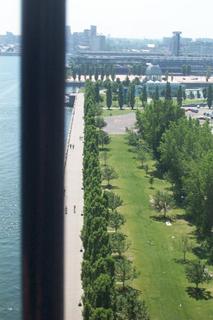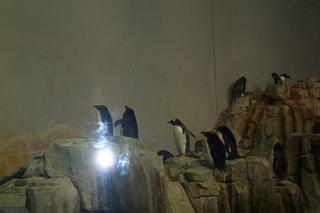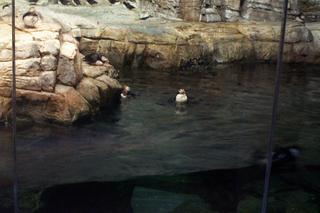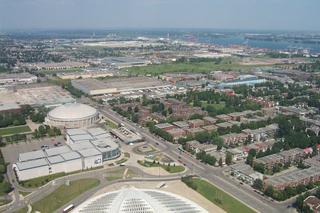 My first stop was the clock tower, with its 192 steps and beautifully visible internal clockworks. There's bits about the tower's history as you climb up the numbered steps, and the visible mechanisms are quite nifty. It's worth noting that the solid concrete steps up to the mechanism are replaced thereafter by a metal spiral staircase with rails on only one side, and if I had trouble psyching myself up to climb those, I can only imagine what certain other members of the family would have thought about it.
My first stop was the clock tower, with its 192 steps and beautifully visible internal clockworks. There's bits about the tower's history as you climb up the numbered steps, and the visible mechanisms are quite nifty. It's worth noting that the solid concrete steps up to the mechanism are replaced thereafter by a metal spiral staircase with rails on only one side, and if I had trouble psyching myself up to climb those, I can only imagine what certain other members of the family would have thought about it. The views are very nice, though. The part of the city that is on the water is generally the best part; it's very built up on one side and wide-open on the other, so you've got all the bustle without any sense of claustrophobia.
The views are very nice, though. The part of the city that is on the water is generally the best part; it's very built up on one side and wide-open on the other, so you've got all the bustle without any sense of claustrophobia.One of the landmarks visible in the second picture, the cold-storage warehouse which was such a point of civic pride for the city during the nineteenth century, is being converted into condos. Technology marches on.
 There's also a lot of nice places to just walk along the river and sit down, which is good, since I decided, after working up a sweat climbing up and down that clock tower, that the river may be a nice way to see the city. So I went to the Saute Moutons jet-boating thing, not initially realizing that while it would spend fifteen minutes or so going up the river, it would then spend the next half hour smashing through rapids. I got very, very wet, almost despairing of drying out before heading back downtown for the evening's films.
There's also a lot of nice places to just walk along the river and sit down, which is good, since I decided, after working up a sweat climbing up and down that clock tower, that the river may be a nice way to see the city. So I went to the Saute Moutons jet-boating thing, not initially realizing that while it would spend fifteen minutes or so going up the river, it would then spend the next half hour smashing through rapids. I got very, very wet, almost despairing of drying out before heading back downtown for the evening's films.Great fun, though - heartily recommended.
Firecracker
* * * (out of four)
Seen 12 July 2005 in Théâtre Hall Concordia (Fantasia)
I generally don't comment much on what the filmmakers say during the Q&A sessions, since it's not really relevant to whether or not someone will enjoy the movie, but one thing producer Clark Balderson brought up rather wigged me out: This movie, based on a true crime story (but with a fair amount of liberties taken), shot on the actual scene of the crime. Which isn't unheard of, when it happens in a public place. But here, we're talking someone's house, in a small town that's only ever had one crime of that nature. Got to be strange. Which, of course, fits with the rest of the movie.
The movie centers around the small town of Wamego, Kansas, in the 1950s. Two young men, Jimmy (Jak Kendall) and David (Mike Patton) live with their aged mother, Eleanor (Karen Black). David has taken over their late father's business and place at the head of the table, and has little use for his sissy, piano-playing brother, except as a target for abuse. When the carnival comes to town, Jimmy sees it as a colorful respite from his home life, especially the girlie show and Sandra, its lead singing attraction (Karen Black again). Little does he know that the last time the carnival came through, David got her pregnant, though the troupe's ringleader (Patton) had the pregnancy brutally terminated. Before too long, Jimmy reaches the end of his rope, and homespun sheriff "Ed" (Susan Traylor) finds herself investigating David's disappearance, while Sandra plots to escape the carnival.
Read the rest at HBS.
R-Point
* * ¾ (out of four)
Seen 12 July 2005 in Théâtre Hall Concordia (Fantasia)
Battlefields are good places to set ghost stories. There is, obviously, an ample supply of restless spirits, and since people have a tendency to fight over the same ground over and over again, the specters will have parallels with the haunted. The haunted will also have weapons that prove utterly useless against their new foes. And if an entire group of people winds up disappearing mysteriously, it's not a loose end that needs to be tied up - it's just something that happens in war.
R-Point posits that it happened a few months earlier - a company of ROK soldiers stationed in Vietnam during the war went into enemy territory and vanished without a trace, but now there's been intermittent radio messages coming from one. Captain Choi Tae-in (Kam Woo-seong) is assigned given a few men (who have been promised an early trip back to Korea) and sent to investigate. When they arrive at "R-Point", they find a marker stating that the Chinese had built a temple over a mass grave and describing a curse, that none who had spilled blood could leave the place, not even their souls. They find the temple - which a group of American soldiers has been using as a supply dump - and start looking for the missing unit. One member is closer than expected.
Read the rest at HBS.
Another Public Enemy (Gonggongui jeog 2)
* * * (out of four)
Seen 12 July 2005 in Salle J.A. de Sève (Fantasia)
Despite that sequel-looking title, no prior experience is necessary to enjoy Kang Woo-suk's Another Public Enemy; it's more a thematic follow-up than a literal one. Anyone who enjoys a slick, corruption-fueled crime drama and is open to Korean cinema is coming in fully equipped, although an extra cushion for your seat wouldn't hurt: At nearly two and a half hours, it sometimes seems to take its time getting to the good stuff.
The film opens some fifteen or twenty years ago, and we meet Kang Chul-jung in high school. He gets involved in a rumble with a neighboring school, but when it comes time for corporal punishment to be handed out, one student, Han Sang-woo, is pulled out from the rest, due to his father's wealth and influence. Kang swears that he will study hard and dedicate himself to fighting that sort of corruption. Flash forward to the present, and Kang (Sol Kyung-gu) is a rising star as a prosecutor, personally leading police on raids to smash gangs. Han (Jeong Joon-ho), meanwhile, has become a monster, selling off his foundation's schools and other less-profitable assets in order to fund a golf academy in America. He even runs down a street cleaner when the man scolds him for littering. When one of Han's partners suggests foul play in the accident that placed Han's older brother in a coma (and Han in charge of the family's foundation) two weeks after his father's death, Kang pounces on the opportunity to take him down - but not only is it dangerous to take a case so personally, but Han wields enough money and influence to create enormous pressure from above to drop the case.
Read the rest at HBS.











